Printer-friendly PDF →
Improving Transportation and Environmental Outcomes
by Implementing Eco-Logical
The goal of the Eco-Logical approach is to enable agencies to achieve better environmental outcomes through a more efficient transportation planning process.
Eco-Logical offers a step-by-step process that is designed to help agencies engage in early collaboration to establish joint environmental priorities for transportation projects.
“By using Eco-Logical, we have accelerated our project delivery, improved our partnerships with resource and regulatory agencies, and reduced environment permit processing times while achieving better environmental outcomes.”
– David Bernhardt
AASHTO President and MaineDOT Commissioner
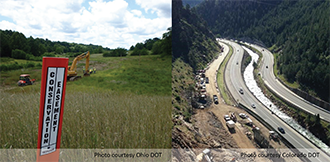
Transportation agencies across the country are experiencing
the value of Implementing Eco-Logical

“By conducting resource conservation and transportation planning at the regional level, you have the potential to improve economies of scale, predictability, and restoration success through collaboration; and better support the protection of species and habitat.”
– Damaris Santiago
Mitigation Team Lead, FHWA
- 13 state departments of transportation (State DOTs) and metropolitan planning organizations (MPOs) received funding through the SHRP2 Implementing Eco-Logical Implementation Assistance Program (IAP).
- 22 other transportation agencies are using Eco-Logical to guide transportation plans or projects.
SHRP2 Solutions in Action
Eco-Logical builds and strengthens partnerships
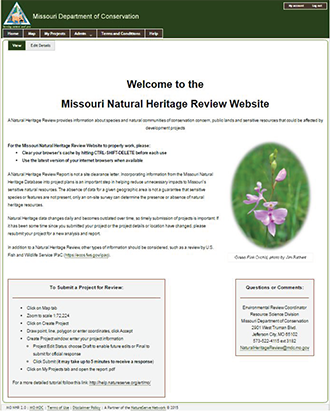
- The Missouri Department of Transportation (MoDOT) partnered with the Missouri Department of Conservation (MDC) to conduct stakeholder outreach to partner agencies as part of its effort to improve the sharing of natural resource information on the MDC Natural Heritage Review website (https://naturalheritagereview.mdc.mo.gov/). MoDOT and MDC’s close coordination, further formalized by a Memorandum of Agreement (MOA) between the two agencies, helped facilitate four stakeholder meetings to collect feedback on needed website updates, identify shared priorities among the partners, and establish best management practices to protect threatened and endangered species from impacts.
“The Natural Heritage Review provided stakeholders and MoDOT with project information, which led to a greater understanding of time frames and planning early in the project. The website is used as a preliminary review and offers easily accessible information that has expedited the process to just 5 minutes.”
– Brittnie Brauner
Missouri Department of Conservation
Agencies are creating Regional Ecosystem Frameworks (REFs), enabling smarter planning
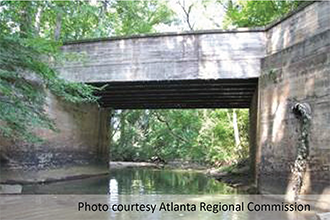
-
The Atlanta Regional Commission (ARC) in Georgia is developing and implementing a Regional Ecosystem Framework (REF) and creating a strategic framework for the Proctor Creek Environmental District (PCED), key watershed in the Atlanta metropolitan area. ARC has expanded the REF spatial coverage to the entire metro Atlanta region, whereby the regional REF is now used to prioritize transportation projects in the region. The REF data composition has also expanded from six resource layers to fifteen.
At the watershed scale, a decision support tool was developed by the Atlanta University Center – Vine City/English Ave Eco-District (AUCED) that incorporates many Eco-Logical principles. The AUCED includes some of the more blighted and underserved areas of the Proctor Creek watershed. The decision support tool will be used now and in the future to select projects that address a number of concerns, ranging from litter, water conservation, and energy efficiency, to restoring the streams and ecologically valuable areas within Proctor Creek.
Contact
Kofi Wakhisi
Supervisor
Program Implementation and Partner Services
KWakhisi@atlantaregional.com
(404) 463-3173
-
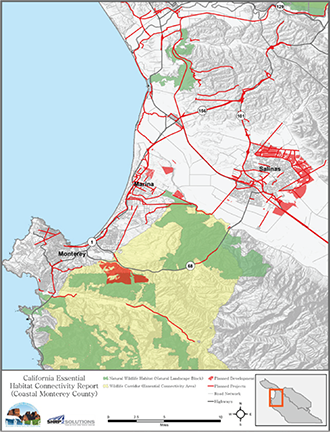
Image courtesy AMBAG
The Association of Monterey Bay Area Governments (AMBAG) in California has created 32 maps incorporating approximately 300 transportation projects, overlaying them with environmental data. The maps include projects that potentially involve significant construction or land redevelopment to help local agencies in the region better understand the connections between regional transportation projects and nearby ecological resources.
The maps will help AMBAG and its partners highlight advanced mitigation opportunities and proactively communicate with resource agencies to determine potential mitigation strategies.
Contact
Heather Adamson
Director of Planning
HAdamson@ambag.org
(831) 264-5086
“The new maps quickly illustrate the environmental resources found in areas where the agency expects transportation projects to be constructed in the next 30 years. This will significantly improve our project delivery in the future.”
– Heather Adamson
Association of Monterey Bay Area Governments
Eco-Logical leads to faster resolutions of programmatic consultations, biological opinions, and permits
-
For Maine Department of Transportation (MaineDOT), a major focus of Eco-Logical is to help reduce the impacts of transportation projects on Atlantic salmon habitat. Through a collaborative effort with the FHWA Resource Center and the U.S. Fish and Wildlife Service (USFWS), using technical support and intensive reviews and discussions, MaineDOT received the Programmatic Biological Opinion on the Atlantic Salmon Programmatic Biological Assessment (PBA) from USFWS.
By adding an additional staff person and using other resources provided through the SHRP2 implementation assistance:
- Approximately 60 percent of MaineDOT’s consultations for Atlantic salmon will be able to be processed within 30 days of submittal.
- Costs associated with delays, redesigns, and redundant reviews will be largely eliminated and NEPA process can be completed earlier in project delivery with more predictable outcomes.
Moreover, the process has become more efficient and disagreements over fish passage will decrease as a result of MaineDOT’s commitment to best management practices for least impact to fish and habitat.
- In addition, working through The Conservation Fund (TCF), the state is developing an in lieu fee mitigation instrument that will provide a consistent, defensible and “user-friendly” mechanism for calculating program credits and fees based on project impacts where Atlantic salmon habitat is affected. This in lieu fee instrument will be available for anyone requiring mitigation for impacts to this species.

An early focus on ecological resources reduces review times and costs when projects move from planning to implementation.

Eco-Logical is Producing Clear Environmental Benefits
Through partnering efforts with a number of local, state, and federal agencies, the Michigan Department of Transportation (MDOT) has achieved a number of successes aimed at improving water quality and advancing environmental conservation. Currently MDOT is working with the Michigan Department of Natural Resources on a policy to address wetland mitigation and is applying its Regional Ecosystem Framework on five major construction projects.
Most significantly, the largest plant mitigation project in Michigan’s history is underway in the I-75 corridor, where 16,000 rare and state-listed threatened plants will be collected for replanting, plant relocation to other conservation lands, and possible storage of topsoil for seed bank redistribution following construction.
Implementing Eco-Logical is a strategy for navigating the project development process approval requirements to efficiently complete projects while reducing impacts on the environment and saving resources.
Using Eco-Logical
- Helps state and local transportation agencies improve decision making
- Minimizes the time and costs associated with planning, environmental reviews, and permitting
- Provides for more effective environmental mitigation
- Capitalizes on environmental enhancement opportunities
- Improves public perception of the transportation project delivery processes
“We at Caltrans find Eco-Logical important because it helps take some of the risk out of project planning. Using it, we were able to work with the resource agency and more quickly identify the location for a needed wildlife crossing on a project – keeping us on schedule.”
– Suzanne Melim
Caltrans
Contact
Suzanne Melim
Supervising Environmental Planner
North Region Office of Environmental Management
Suzanne.Melim@dot.ca.gov
(530) 741-4484
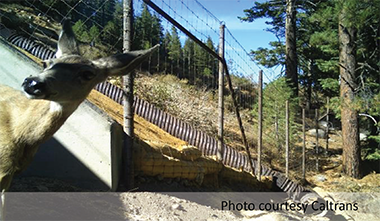
Available Resources
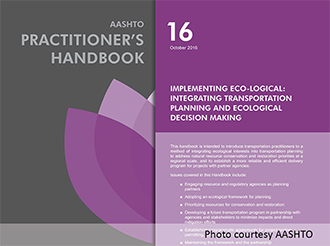
“In Ohio, we are using the AASHTO Eco-Logical Practitioner’s Handbook as handbooks to train new staff, and to provide a detailed overview of complex topics for all our users.”
– Tim Hill
Administrator
Office of Environmental Services
Ohio Department of Transportation
Further information is also available at:
www.fhwa.dot.gov/GoSHRP2 or https://shrp2.transportation.org/Pages/Default.aspx

